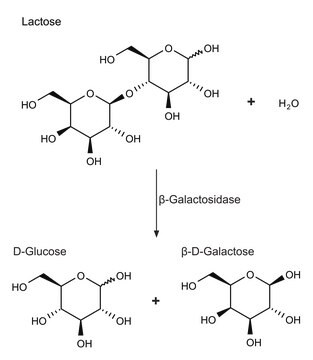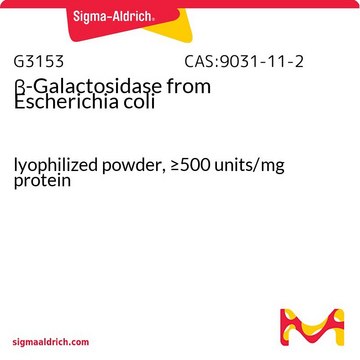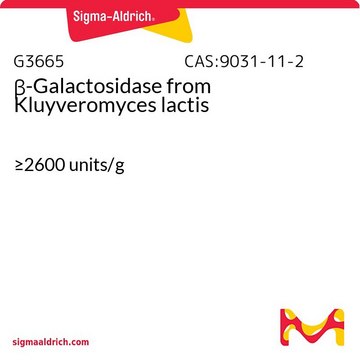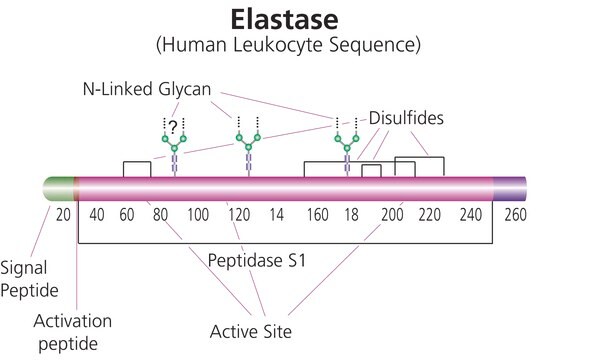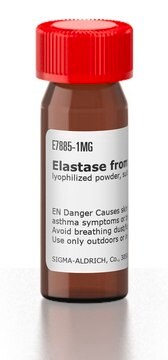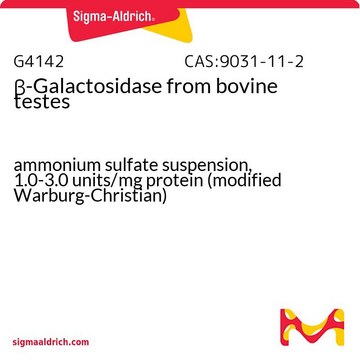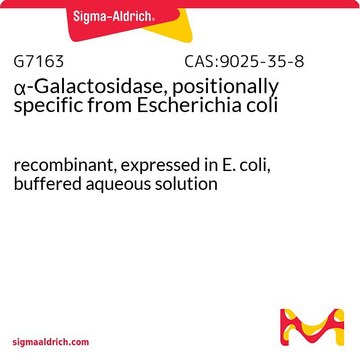G5160
β-Galactosidase from Aspergillus oryzae
≥8.0 units/mg solid
Synonym(s):
β-D-Galactoside galactohydrolase, Lactase from Aspergillus oryzae
Sign Into View Organizational & Contract Pricing
All Photos(3)
About This Item
Recommended Products
form
solid
Quality Level
specific activity
≥8.0 units/mg solid
contains
dextrin as extender
storage temp.
−20°C
Looking for similar products? Visit Product Comparison Guide
General description
β-Galactosidase is a member of the glycoside hydrolase clan A (GH-A) family. It is widely present in microorganisms, which includes both prokaryotes and eukaryotes.
Application
β-Galactosidase from Aspergillus oryzae has been used:
- in in vitro nuclear magnet resonance (NMR)
- as a standard in the β-galactosidase assay to determine the concentration of cell-associated β-galactosidase
- to modify sugar residues on the surface of the mutant slime cells to study the adhesive properties
- for enzymatic hydrolysis of lactose
- for reversed-phase (RP) adsorption
- in the hydrolysis of whey lactose
Biochem/physiol Actions
β-Galactosidase acts on the terminal β-D-galactosyl moieties of disaccharides, glycoconjugates, and polysaccharides. It is useful in mediating transglycosylation reactions such as the synthesis of galactooligosaccharides (GOS). β-Galactosidases might be used for glycobiological and biotechnological applications.
β-galactosidase cleaves lactose into its monosaccharide components, glucose and galactose. It also catalyses the transglycosylation of glucose into allolactose, the inducer of β-galactosidase, in a feedback loop.
Unit Definition
One unit will hydrolyze 1.0 μmole of lactose per minute at pH at 4.5 at 30 °C.
inhibitor
Product No.
Description
Pricing
substrate
Product No.
Description
Pricing
Storage Class
11 - Combustible Solids
wgk_germany
WGK 3
flash_point_f
Not applicable
flash_point_c
Not applicable
ppe
Eyeshields, Gloves, type N95 (US)
Certificates of Analysis (COA)
Search for Certificates of Analysis (COA) by entering the products Lot/Batch Number. Lot and Batch Numbers can be found on a product’s label following the words ‘Lot’ or ‘Batch’.
Already Own This Product?
Find documentation for the products that you have recently purchased in the Document Library.
Customers Also Viewed
Hydrolysis of whey lactose by immobilized β-Galactosidase
Marcela Panaro Mariotti; Hideko Yamanaka; Angela Regina Araujo; Henrique Celso Trevisan
Brazilian Archives of Biology and Technology, 51 (2008)
Modular process for the flexible synthesis of magnetic beads-Process and product validation
Birgit Hickstein1, and Urs Alexander Peuker
Journal of Applied Polymer Science, 112, 2366-2373 (2009)
Jian-Xin Yu et al.
NMR in biomedicine, 21(7), 704-712 (2008-02-22)
Gene therapy has emerged as a promising strategy for treatment of various diseases. However, widespread implementation is hampered by difficulties in assessing the success of transfection in the target tissue and the longevity of gene expression. Thus, there is increasing
A Y Dunina-Barkovskaya et al.
The Journal of membrane biology, 198(2), 77-87 (2004-05-13)
Low gadolinium concentrations induce rapid gigaseal formation and cell adhesion to glass and plastic (polystyrene) substrates in the slime mutant of Neurospora crassa. Cellular adhesion is independent of an integrin-mediated mechanism, because pretreatment with the oligopeptide ARG-GLY-ASP-SER (RGDS) did not
Daniel Muñoz-Espín et al.
EMBO molecular medicine, 10(9) (2018-07-18)
Senescent cells accumulate in multiple aging-associated diseases, and eliminating these cells has recently emerged as a promising therapeutic approach. Here, we take advantage of the high lysosomal β-galactosidase activity of senescent cells to design a drug delivery system based on
Our team of scientists has experience in all areas of research including Life Science, Material Science, Chemical Synthesis, Chromatography, Analytical and many others.
Contact Technical Service